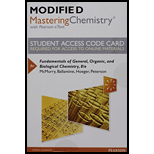
Concept explainers
(a)
Interpretation:
The product of the given reaction to be predicted
Concept Introduction:
Addition reaction: A general reaction type in which a substance X-Y adds to the multiple bond of an unsaturated reactant to yield a saturated product that has only single bonds.
Hydration: The Addition of water to a multiple bond to give an alcohol product. An
Markovnikov’s rule: In the addition of
(b)
Interpretation:
The product of the given reaction to be predicted
Concept Introduction:
Addition reaction: A general reaction type in which a substance X-Y adds to the multiple bond of an unsaturated reactant to yield a saturated product that has only single bonds.
Hydration: The Addition of water to a multiple bond to give an alcohol product. An alkene does not react with pure water alone; it requires a small amount of acid to catalyst the reaction.
Markovnikov’s rule: In the addition of
(c)
Interpretation:
The product of the given reaction to be predicted
Concept Introduction:
Addition reaction: A general reaction type in which a substance X-Y adds to the multiple bond of an unsaturated reactant to yield a saturated product that has only single bonds.
Hydration: The Addition of water to a multiple bond to give an alcohol product. An alkene does not react with pure water alone; it requires a small amount of acid to catalyst the reaction.
Markovnikov’s rule: In the addition of
Want to see the full answer?
Check out a sample textbook solution
Chapter 13 Solutions
Modified Mastering Chemistry With Pearson Etext -- Standalone Access Card -- For Fundamentals Of General, Organic, And Biological Chemistry (8th Edition)
- In the preparation of aspirin, You can do the functional group test to ensure the completion of the reaction. (a) What is the name of reagent used? (b) What is your observation if any unreacted starting material is present? (c) What is the name of the functional group responsible for this reaction?arrow_forwardWhat coefficients must be placed in the following blanks sothat all atoms are accounted for in the products?C6H12O6 S _________ C2H6O + _________ CO2(A) 2; 1(B) 3; 1(C) 1; 3(D) 2; 2arrow_forwardThe reaction of methoxy benzene with hydrogen iodide will yield a phenol and an alkyl halide. Which of following choices is the correct combination of the products?arrow_forward
- What are the products of the following reactions: AMP +H2O + H+arrow_forwardWhat is the carbohydrate classification for the product produced when each of the following undergoes complete hydrolysis?arrow_forwardWith the given structures, arrange the following compounds in order of decreasing reactivity towards hydrolysisarrow_forward
- What coefficients must be placed in the following blanks so that all atoms are accounted for in the products?C6H12O6 → ________ C2H6O + ________ CO2 Group of answer choices A. 2; 1 B. 3; 1 C. 1; 3 D. 2; 2arrow_forwardIf the phosphorus atom in 3-phosphoglycerate is radioactively labeled, where will the label be when the reaction that forms 2-phosphoglycerate is over?arrow_forwardThe metabolic intermediate acetyl phosphate is an anhydride formed from acetic acid and phosphoric acid. What is the structure of acetyl phosphate?arrow_forward
- What structural feature is necessary for an alcohol to undergo oxidation reactions?arrow_forwardDraw all possible carboxylic acids with the formula C5H10O2.arrow_forwardConsider the intermolecular forces present in a pure sample of each of the following compounds: CH₃CH₂OH and CH₃COCH₃. Identify the intermolecular forces that these compounds have in common.arrow_forward
 Anatomy & PhysiologyBiologyISBN:9781938168130Author:Kelly A. Young, James A. Wise, Peter DeSaix, Dean H. Kruse, Brandon Poe, Eddie Johnson, Jody E. Johnson, Oksana Korol, J. Gordon Betts, Mark WomblePublisher:OpenStax College
Anatomy & PhysiologyBiologyISBN:9781938168130Author:Kelly A. Young, James A. Wise, Peter DeSaix, Dean H. Kruse, Brandon Poe, Eddie Johnson, Jody E. Johnson, Oksana Korol, J. Gordon Betts, Mark WomblePublisher:OpenStax College


